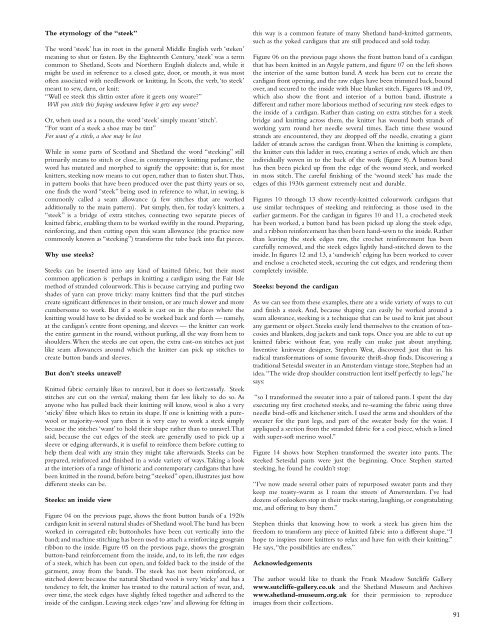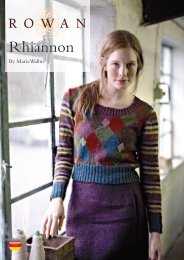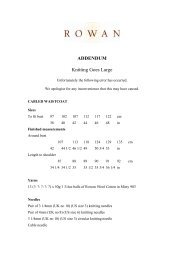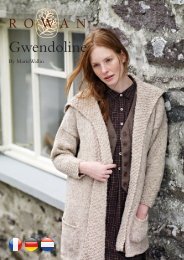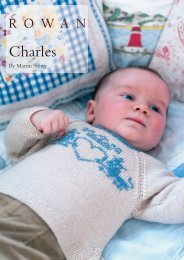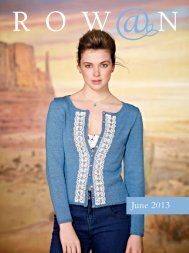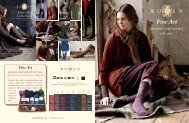Create successful ePaper yourself
Turn your PDF publications into a flip-book with our unique Google optimized e-Paper software.
The etymology of the “steek”The word ‘steek’ has its root in the general Middle English verb ‘steken’meaning to shut or fasten. By the Eighteenth Century, ‘steek’ was a termcommon to Shetland, Scots and Northern English dialects and, while itmight be used in reference to a closed gate, door, or mouth, it was mostoften associated with needlework or knitting. In Scots, the verb, ‘to steek’meant to sew, darn, or knit:“Wull ee steek this slittin oxter afore it geets ony woare?”Will you stitch this fraying underarm before it gets any worse?Or, when used as a noun, the word ‘steek’ simply meant ‘stitch’.“For want of a steek a shoe may be tint”For want of a stitch, a shoe may be lostWhile in some parts of Scotland and Shetland the word “steeking” stillprimarily means to stitch or close, in contemporary knitting parlance, theword has mutated and morphed to signify the opposite: that is, for mostknitters, steeking now means to cut open, rather than to fasten shut. Thus,in pattern books that have been produced over the past thirty years or so,one finds the word “steek” being used in reference to what, in sewing, iscommonly called a seam allowance (a few stitches that are workedadditionally to the main pattern). Put simply, then, for today’s knitters, a“steek” is a bridge of extra stitches, connecting two separate pieces ofknitted fabric, enabling them to be worked swiftly in the round. Preparing,reinforcing, and then cutting open this seam allowance (the practice nowcommonly known as “steeking”) transforms the tube back into flat pieces.Why use steeks?Steeks can be inserted into any kind of knitted fabric, but their mostcommon application is perhaps in knitting a cardigan using the Fair Islemethod of stranded colourwork. This is because carrying and purling twoshades of yarn can prove tricky: many knitters find that the purl stitchescreate significant differences in their tension, or are much slower and morecumbersome to work. But if a steek is cast on in the places w<strong>here</strong> theknitting would have to be divided to be worked back and forth — namely,at the cardigan’s centre front opening, and sleeves — the knitter can workthe entire garment in the round, without purling, all the way from hem toshoulders. When the steeks are cut open, the extra cast-on stitches act justlike seam allowances around which the knitter can pick up stitches tocreate button bands and sleeves.But don’t steeks unravel?Knitted fabric certainly likes to unravel, but it does so horizontally. Steekstitches are cut on the vertical, making them far less likely to do so. Asanyone who has pulled back their knitting will know, wool is also a very‘sticky’ fibre which likes to retain its shape. If one is knitting with a purewoolor majority-wool yarn then it is very easy to work a steek simplybecause the stitches ‘want’ to hold their shape rather than to unravel. Thatsaid, because the cut edges of the steek are generally used to pick up asleeve or edging afterwards, it is useful to reinforce them before cutting tohelp them deal with any strain they might take afterwards. Steeks can beprepared, reinforced and finished in a wide variety of ways. Taking a lookat the interiors of a range of historic and contemporary cardigans that havebeen knitted in the round, before being “steeked” open, illustrates just howdifferent steeks can be.Steeks: an inside viewFigure 04 on the previous page, shows the front button bands of a 1920scardigan knit in several natural shades of Shetland wool. The band has beenworked in corrugated rib; buttonholes have been cut vertically into theband; and machine stitching has been used to attach a reinforcing grosgrainribbon to the inside. Figure 05 on the previous page, shows the grosgrainbutton-band reinforcement from the inside, and, to its left, the raw edgesof a steek, which has been cut open, and folded back to the inside of thegarment, away from the bands. The steek has not been reinforced, orstitched down: because the natural Shetland wool is very ‘sticky’ and has atendency to felt, the knitter has trusted to the natural action of wear, and,over time, the steek edges have slightly felted together and ad<strong>here</strong>d to theinside of the cardigan. Leaving steek edges ‘raw’ and allowing for felting inthis way is a common feature of many Shetland hand-knitted garments,such as the yoked cardigans that are still produced and sold today.Figure 06 on the previous page shows the front button band of a cardiganthat has been knitted in an Argyle pattern, and figure 07 on the left showsthe interior of the same button band. A steek has been cut to create thecardigan front opening, and the raw edges have been trimmed back, boundover, and secured to the inside with blue blanket stitch. Figures 08 and 09,which also show the front and interior of a button band, illustrate adifferent and rather more laborious method of securing raw steek edges tothe inside of a cardigan. Rather than casting on extra stitches for a steekbridge and knitting across them, the knitter has wound both strands ofworking yarn round her needle several times. Each time these woundstrands are encountered, they are dropped off the needle, creating a giantladder of strands across the cardigan front. When the knitting is complete,the knitter cuts this ladder in two, creating a series of ends, which are thenindividually woven in to the back of the work (figure 8). A button bandhas then been picked up from the edge of the wound steek, and workedin moss stitch. The careful finishing of the ‘wound steek’ has made theedges of this 1930s garment extremely neat and durable.Figures 10 through 13 show recently-knitted colourwork cardigans thatuse similar techniques of steeking and reinforcing as those used in theearlier garments. For the cardigan in figures 10 and 11, a crocheted steekhas been worked, a button band has been picked up along the steek edge,and a ribbon reinforcement has then been hand-sewn to the inside. Ratherthan leaving the steek edges raw, the crochet reinforcement has beencarefully removed, and the steek edges lightly hand-stitched down to theinside. In figures 12 and 13, a ‘sandwich’ edging has been worked to coverand enclose a crocheted steek, securing the cut edges, and rendering themcompletely invisible.Steeks: beyond the cardiganAs we can see from these examples, t<strong>here</strong> are a wide variety of ways to cutand finish a steek. And, because shaping can easily be worked around aseam allowance, steeking is a technique that can be used to knit just aboutany garment or object. Steeks easily lend themselves to the creation of teacosiesand blankets, dog jackets and tank tops. Once you are able to cut upknitted fabric without fear, you really can make just about anything.Inventive knitwear designer, Stephen West, discovered just that in hisradical transformations of some favourite thrift-shop finds. Discovering atraditional Setesdal sweater in an Amsterdam vintage store, Stephen had anidea. “The wide drop shoulder construction lent itself perfectly to legs,” hesays:“so I transformed the sweater into a pair of tailored pants. I spent the dayexecuting my first crocheted steeks, and re-seaming the fabric using threeneedle bind-offs and kitchener stitch. I used the arms and shoulders of thesweater for the pant legs, and part of the sweater body for the waist. Iappliqued a section from the stranded fabric for a cod piece, which is linedwith super-soft merino wool.”Figure 14 shows how Stephen transformed the sweater into pants. Thesteeked Setesdal pants were just the beginning. Once Stephen startedsteeking, he found he couldn’t stop:“I’ve now made several other pairs of repurposed sweater pants and theykeep me toasty-warm as I roam the streets of Amersterdam. I’ve haddozens of onlookers stop in their tracks staring, laughing, or congratulatingme, and offering to buy them.”Stephen thinks that knowing how to work a steek has given him thefreedom to transform any piece of knitted fabric into a different shape. “Ihope to inspires more knitters to relax and have fun with their knitting.”He says, “the possibilities are endless.”AcknowledgementsThe author would like to thank the Frank Meadow Sutcliffe Gallerywww.sutcliffe-gallery.co.uk and the Shetland Museum and Archiveswww.shetland-museum.org.uk for their permission to reproduceimages from their collections.91


